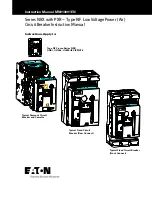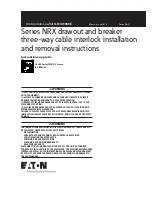
• Trip / Alarm settings
- System settings
- Current trip protection settings
- Voltage trip protection settings
- Frequency trip protection settings
- Power trip protection settings
- Current alarm protection settings
- Voltage alarm protection settings
- Frequency alarm protection settings
- Power alarm protection settings
- Other alarms
- Relay settings
• Communications settings for all the types of
communication modules that are available. This includes
baud rate, or special start stop and flow control settings
• Time settings for time and date event stamping
• PGM Transfer setting to download or upload the setpoints
to the communications module
• Firmware settings includes the trip unit and the display
module version and revision
Programming Setpoints Submenu Icon
The protection curve with adjustment tools icon indicates the
submenu for setpoint viewing and adjustment capabilities. This
submenu will allow display of the full range of each setpoint
that is available. Some of the setpoints are for display only and
are not adjustable. Under the system settings submenu the
style of the trip unit and the rating plug are examples of non-
adjustable setpoints. The tripping, alarming, communication,
time and date, PGM transfer and firmware settings are available
in this submenu. Unless the SAVE pushbutton is available to
the user, the setpoints will not be saved after adjustment. If
the user does not exit the Program Setpoints submenu with a
save
action or an escape action, the display will time out. After
approximately 10 minutes the display will abandon the setpoint
changes and go back to the main menu screens.
Test Submenu Icon
The test clip board and check list indicates the submenu for
testing related functions. From this submenu a phase test
or a ground test can be initiated. Various current levels can
be selected for checking the timing and programming of the
setpoints to ensure proper coordination. The value of current
selected for the test is based on a multiple of the In (rating
plug) value. An action of tripping or not tripping the circuit
breaker can be selected for each test.
Health Submenu Icon
This symbol indicates the health and wellness submenu which
will provide diagnostic information on the circuit breaker’s
health as well as a history of the circuit breaker and the
power system it is protecting. This data is useful for planning
maintenance and inspection schedules.
A counter shows the number of Long Delay and Ground events
that were encountered while in service. Another counter
shows the number of faults (Short Delay and Instantaneous)
that were encountered while in service. The internal test
function will not increment the counters, however, there may
be count values in these registers from the factory primary
injection testing. The operations counter provides data on the
number of close operations experienced by the circuit breaker.
Each of these three values can be reset to zero. The overload
and ground counter will roll over at a value of 255 while the
operation counter will roll over at 65,000.
The health submenu will show when the last time the circuit
breaker was operated (opened or tripped) with time and date
displayed of the last operation.
Also included in this submenu is the maximum temperature
and the current temperature in degrees centigrade as seen by
the trip unit microprocessor.
All stored data requires external trip unit power and once
captured is stored in nonvolatile memory.
23
EATON
www.eaton.com
Effective September 2013
Instructional Leaflet IL01301064E
Operating Manual for Series NRX
Digitrip Trip Units 1150 / 1150i









































